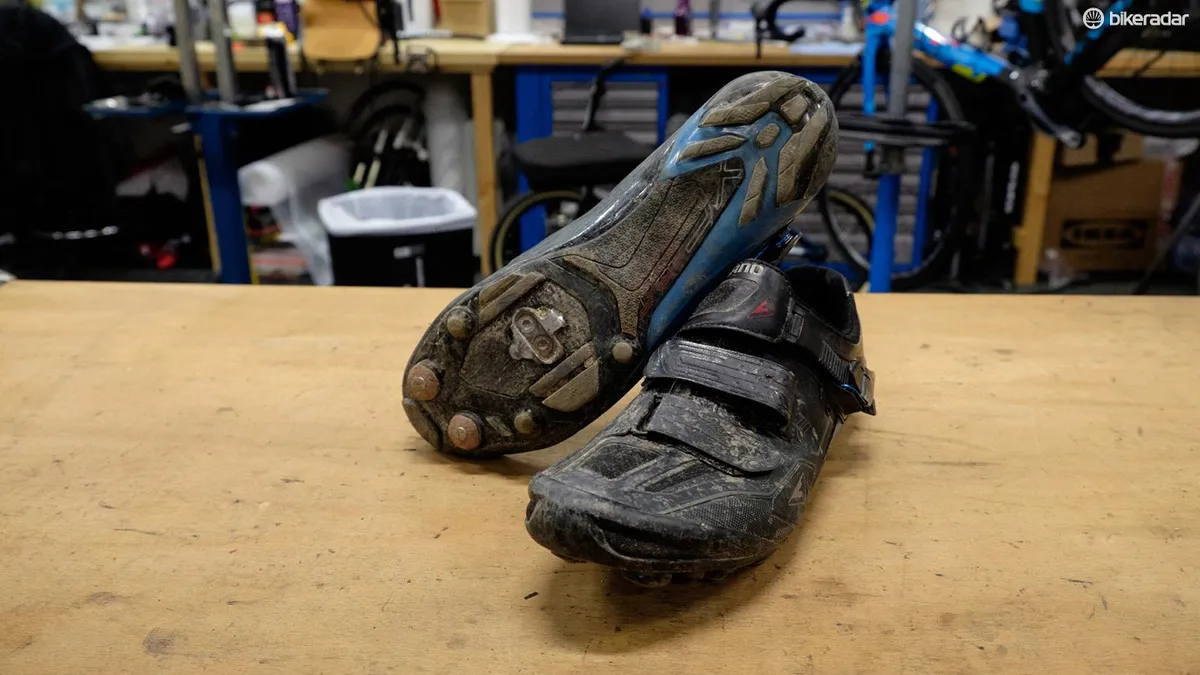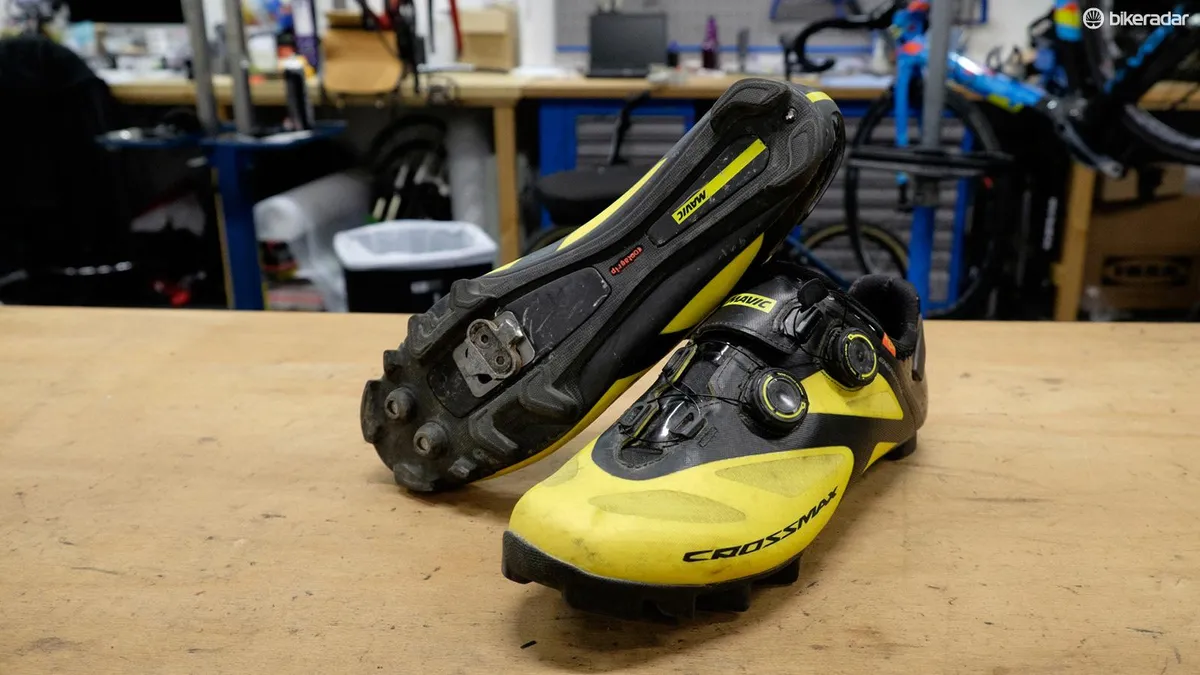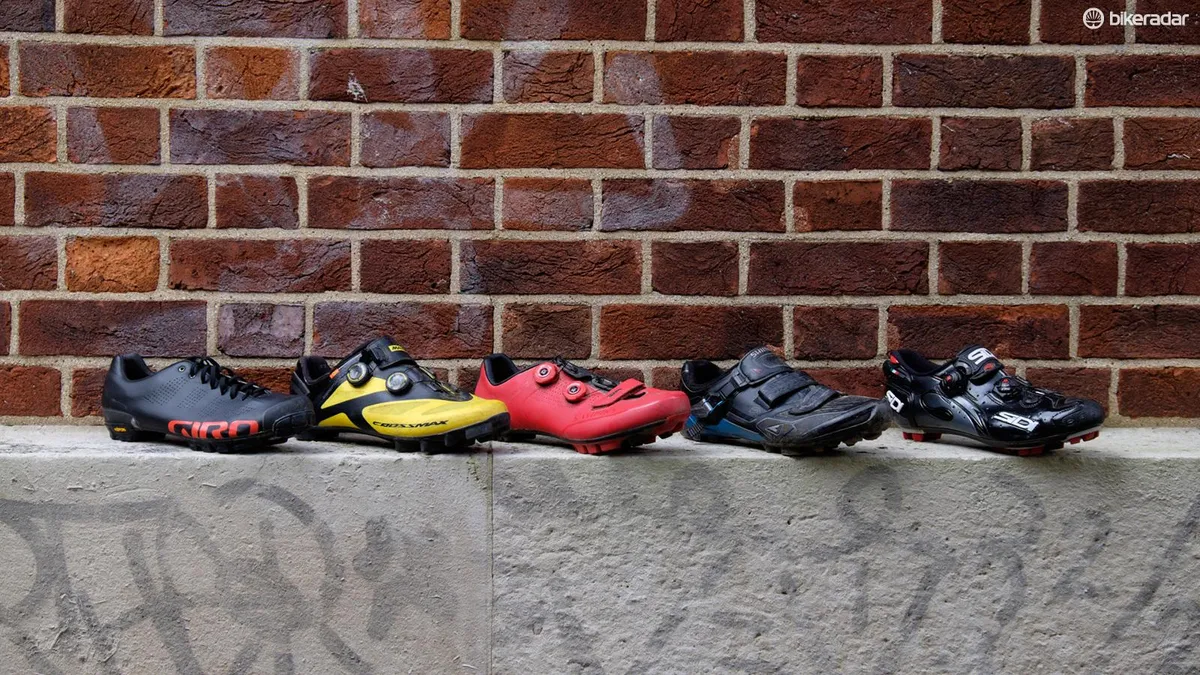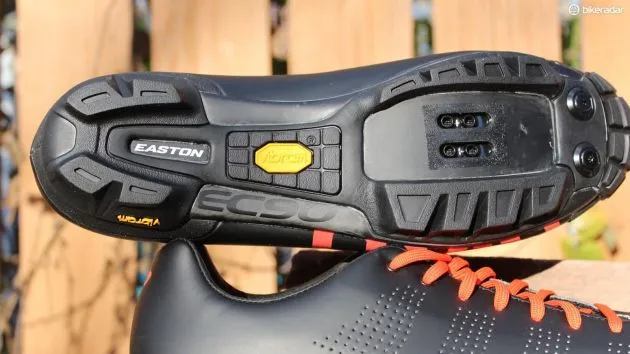Cross Country racing is one of the most physically demanding disciplines in all of cycling, with rider and bike flirting the limits of low weight and huge power on technically demanding courses. Footwear must follow suit, so the best will combine class-leading stiffness, low weight, comfortable fit and a durable finish.
- Best bike clothing: all our guides in one place
- Dropper post vs fixed post. Which is faster for XC racing?
- Cross-country shoe showdown: Specialized S-Works XC vs Sidi Drako
There’s a wide variety of options available for those wanting to pin on a number, so we’ve picked five of the best, plus a buyers guide to help you know what to look out for when purchasing your XC kicks.So what do I need to look out for?
Fit
No matter how light/stiff/shiny/fluoro your new shoes are, if they don’t fit correctly, you could find yourself in a whole load of bother; think hot spots, blisters, painful arches and worse.
Everyone’s foot is different, so always try on before you buy. In our test, every shoe had a different style of width, last shape, toe box and heel retention capability when riding, so what may suit one rider, won’t suit another.
Basics to look out for are to make sure your toes have some wiggle room and aren’t being crushed in the end of the shoe. Your heel must sit securely in the shoe and not lift when riding or putting down the power. Finally there should be no hot spots or seams digging in your feet when the shoes are tightened up. Your local bike shop will be able to help with correct sizing, so that’s the number one place to start.
Retention system
Within our test there were a variety of retention systems to keep your foot securely in place. The most common were the BOA style dials, offering quick and easy adjustment when out on the trail. They’re probably the most prone to breaking, due to the small parts and thin wires involved — although none of ours failed during the test.
The classic ratchet strap paired with Velcro is another option, being perhaps more reliable than the BOA style. The cost is a slight increase in weight and the extra bulk a ratchet creates.
The final option is laces, being the lightest and cheapest to replace, although you looe any chance of on the fly adjustment and we found that they’re prone to collecting mud in poor conditions.
Sole
Carbon rules the day when it comes to XC shoes, simply because of its feathery weight and supreme stiffness. But there’s much more to a great XC shoe sole than a sheet of carbon fibre.
Tread profile/density is also very important. Some shoes offer a lightweight minimal tread, which is great for racing, but will come up short if you need to run or walk anywhere when out on the trail. Others offered more grip and protection for the sole at a small weight penalty.
A final consideration is durability/longevity. Unfortunately only one shoe on test came with replaceable lugs on the sole (Sidi), the rest were permanently moulded, meaning once they’re worn out the shoes are finished. When paying this much for footwear we’d love to see replaceable treads across the board, but don’t see it happening anytime soon.
Protection
Mountain biking is hard on your body and equipment, so shoes need to offer a degree of protection from rocks, roots and other nasties without becoming too bulky. The areas most prone to damage are the toe box, heel and where the shoe may rub the crank. All the shoes on test offered some form of protection (some better than others), so if you’re particularly hard on you kit the extra weight may be worth the sacrifice.
Weight
Weight is obviously very important in a sport where climbing speed is paramount, because the lighter you are the quicker you’ll climb. Most high-end shoes are light, but some are lighter than others and worth considering if you’re counting the grams.
Ventilation
A final consideration, especially if you live somewhere warm, is ventilation. Most shoes have ventilation in the form of small holes or mesh panels, which do a good job of keeping your feet cool. But remember it’s a double edged sword and a well ventilated shoe can be problematic in colder climates, so if you suffer in temperature extremes it’s worth bearing in mind.
Specialized S-Works

• Price: £250 / US$N/A / AU$N/A• Specialized• Best for: Best overall
Specialized is another company with a reputation for high performance footwear and the S-Works represents its latest and greatest. Fit is subjective, but we found the S-Works suited our feet the best, they weren’t too narrow or too wide, provided good arch support and enveloped our whole foot without any hot spots.
The BOA retention system was also our favourite on test, with small precise adjustment available like the Mavics, but also giving the solid, locked in feel of the Sidis.
A word of caution to cyclocross riders though, in extremely wet conditions the smooth lugs don’t offer much grip, as one colleagues painful hip will attest to after slipping over in a race. They’re also not replaceable so can’t compete with the longevity of the Sidis.
Overall the Specialized came out a clear winner with a great fit, feathery weight and relative durability, although they’re not without their faults. Make the tread replaceable with better grip and we suspect they’d get close to a perfect score.
Giro Empire VR90

• Price: £220 / US$300 / AU$350• Giro• Best for: Feathery weightWith a lightweight but durable upper, a stiff carbon sole clad in soft Vibram rubber, and a lace-up closure, the Giro Empire VR90 shoes are a great option for cross-country riding, and good for fair-weather cyclocross.
My test pair of 45.5 shoes weighed 700g. I normally wear 45, but I had to go up a half size because the VR90s fit snugly through the forefoot. While many other Giro shoes come in wide options, the VR90s do not.
So, about the laces. They work surprisingly well. Of course you're familiar with lacing up your street shoes. The main questions we had were, will the laces come untied while riding or get tangled in the chain or pedals, and will they loosen up or need to be retied mid-ride? The answer to all of that is no.
Internally, the Empire VR90s have a neutral fit, and the instep can be adjusted via Velcro wedges on the bottom of the anti-microbial insoles.
The Teijin microfiber uppers proved easy to maintain. After muddy rides I would just scrub the shoes with a brush and soapy water after washing the bike. The absence of seams on the uppers makes for an easy clean; the laces and eyelets make for a little more work, but clean up fairly easy, too.
Shimano SH-XC90

• Price: £200 / US$N/A / AU$N/A• Shimano• Best for: Toughness
The Shimano SH-XC90 has been around for a while now, having a somewhat old-school look with its ratchet and Velcro closure system, but their performance was up there with the best on test.
Like the two previous generations, the XC90’s offer a custom fit (heat moulding) option for the inner sole and uppers. They’re also available in half sizing and wide fits, so there should be a size to suit most feet. Our regular size 45 fitted just fine, so we never felt the need to use the heat moulding during the test.
The XC90’s can be further customised with arch inserts similar to the Giro’s, this helps ensure you get a truly secure fit. In fact, bar the Specialized the Shimanos were the most secure on test, thanks to a deep heel cup and strong retention system.
The XC90s accompanied us on some tough photo shoots, where long rides hiking rocky terrain were the order of the day. Unsurprisingly they took the unforgiving ground in their stride, showing little wear from the time spent walking.
Where the Shimano fell slightly short was on weight, being the heaviest on test, but if you value toughness over lightness the XC90s come highly recommended.
Sidi Drako

• Price: £250 / US$500 / AU$480• Best for: longevity • Sidi
Sidi has a huge pedigree in high performance footwear, being worn by possibly the greatest male XC riders of all time, Nino Schurter and Julien Absalon, so it’s safe to say the Drakos won’t slow you down.
The Techno-3 Dials were the most secure on test with thicker wires and strong definitive clicks when cranking them tight. They are a little fiddly with a small button needing to be pressed before adjustment, making changes on the fly difficult and nigh on impossible in a race situation.
The heel cup was also secure and comfortable with the added bonus of two small screws, which can be tightened to ensure a super snug fit, although we never felt the need to use them.
The Drakos get a huge thumbs-up due to the fact that nearly everything on the shoe is replaceable. This includes the sole tread and straps so, while expensive, they should last you a long time.
This durability does come at a cost, as there’s no rubber protection on the sole. It might not seem like a big deal, but if you come unclipped on a descent or miss a pedal all that exposed carbon is like ice, making it difficult to stay in control.
Mavic Crossmax SL Ultimate

• Price: £265 / US$400 / AU$TBC
• Best for: Comfort
• Mavic
With its plush internal liner and generously wide toe box, the Mavics were definitely the most comfortable on test, keeping our feet happy after many hours in the saddle. Mavic’s Ortholite insole also adds to the comfort, perhaps at the expense of feeling slightly disconnected from the pedals, but we didn’t feel any loss of power due to this.
The outer sole has plenty of rubber tread to protect all that carbon fibre and there’s the option to add studs for your cyclocross needs. Like the rest on test, it’s almost unyieldingly stiff, so you won’t be wasting any of those precious watts.
Similar to the rest of the shoe, the heel cup is very plush and comfortable, but did seem to slip more than any other shoe on test. Although this was more apparent when walking and we had minimal slip when pedalling.
Being light, comfortable and secure the Mavics would have been a strong contender for the win, were it not for one unfortunate issue appearing after only three rides. The inside of each shoe suffered badly from crank rub, immediately wearing through the black finish to the yellow rubber below. For such a high-end shoe this is a big deal and we’d like to see some more protection where the shoe inevitably hits the crank arm.






